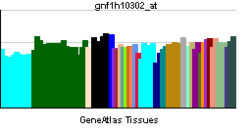OR51E1
Olfactory receptor 51E1 is a protein that in humans is encoded by the OR51E1 gene.[3]
Olfactory receptors interact with odorant molecules in the nose, to initiate a neuronal response that triggers the perception of a smell. The olfactory receptor proteins are members of a large family of G-protein-coupled receptors arising from single coding-exon genes. Olfactory receptors share a 7-transmembrane domain structure with many neurotransmitter and hormone receptors and are responsible for the recognition and G protein-mediated transduction of odorant signals. The olfactory receptor gene family is the largest in the genome. The nomenclature assigned to the olfactory receptor genes and proteins for this organism is independent of other organisms.[3]
See also
References
Further reading
- Wang J, Weng J, Cai Y, et al. (2006). "The prostate-specific G-protein coupled receptors PSGR and PSGR2 are prostate cancer biomarkers that are complementary to alpha-methylacyl-CoA racemase". Prostate. 66 (8): 847–57. doi:10.1002/pros.20389. PMID 16491480.
- Weng J, Wang J, Hu X, et al. (2007). "PSGR2, a novel G-protein coupled receptor, is overexpressed in human prostate cancer". Int. J. Cancer. 118 (6): 1471–80. doi:10.1002/ijc.21527. PMID 16206286.
- Gerhard DS, Wagner L, Feingold EA, et al. (2004). "The status, quality, and expansion of the NIH full-length cDNA project: the Mammalian Gene Collection (MGC)". Genome Res. 14 (10B): 2121–7. doi:10.1101/gr.2596504. PMC 528928
 . PMID 15489334.
. PMID 15489334.
- Weigle B, Fuessel S, Ebner R, et al. (2004). "D-GPCR: a novel putative G protein-coupled receptor overexpressed in prostate cancer and prostate". Biochem. Biophys. Res. Commun. 322 (1): 239–49. doi:10.1016/j.bbrc.2004.07.106. PMID 15313197.
- Malnic B, Godfrey PA, Buck LB (2004). "The human olfactory receptor gene family". Proc. Natl. Acad. Sci. U.S.A. 101 (8): 2584–9. doi:10.1073/pnas.0307882100. PMC 356993
 . PMID 14983052.
. PMID 14983052.
- Vanti WB, Nguyen T, Cheng R, et al. (2003). "Novel human G-protein-coupled receptors". Biochem. Biophys. Res. Commun. 305 (1): 67–71. doi:10.1016/S0006-291X(03)00709-5. PMID 12732197.
- Strausberg RL, Feingold EA, Grouse LH, et al. (2003). "Generation and initial analysis of more than 15,000 full-length human and mouse cDNA sequences". Proc. Natl. Acad. Sci. U.S.A. 99 (26): 16899–903. doi:10.1073/pnas.242603899. PMC 139241
 . PMID 12477932.
. PMID 12477932.
- Adams MD, Kerlavage AR, Fleischmann RD, et al. (1995). "Initial assessment of human gene diversity and expression patterns based upon 83 million nucleotides of cDNA sequence" (PDF). Nature. 377 (6547 Suppl): 3–174. PMID 7566098.
External links
This article incorporates text from the United States National Library of Medicine, which is in the public domain.
|
|---|
|
Class I
(fish-like specific receptors) | Family 51 | |
|---|
| Family 52 | |
|---|
| Family 56 | |
|---|
|
|---|
|
Class II
(tetrapod specific receptors) | Family 1 | |
|---|
| Family 2 | |
|---|
| Family 3 | |
|---|
| Family 4 | |
|---|
| Family 5 | |
|---|
| Family 6 | |
|---|
| Family 7 | |
|---|
| Family 8 | |
|---|
| Family 9 | |
|---|
| Family 10 | |
|---|
| Family 11 | |
|---|
| Family 12 | |
|---|
| Family 13 | |
|---|
|
|---|

 . PMID 15489334.
. PMID 15489334. . PMID 14983052.
. PMID 14983052. . PMID 12477932.
. PMID 12477932.